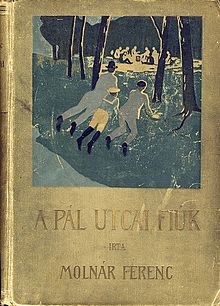The Paul Street Boys
 First edition | |
| Author | Ferenc Molnár |
|---|---|
| Original title | A Pál utcai fiúk |
| Language | Hungarian |
| Genre | youth novel |
Publication date | 1906 |
| Publication place | Hungary |
The Paul Street Boys (Template:Lang-hu) is a youth novel by the Hungarian writer Ferenc Molnár, first published in 1906.
Plot outline
The novel is about schoolboys in Józsefváros neighbourhood of Budapest and set in 1889. The Paul Street Boys spend their free time at the grund, an empty lot that they regard as their "Fatherland".[1][2] The story has two main protagonists, János Boka (the honourable leader of the Paul Street Boys) and Ernő Nemecsek (the smallest member of the group).[3][4]
When the "Redshirts"—another gang of boys, led by Feri Áts, who gather at the nearby botanical gardens—attempt to take over the grund,[5] the Paul Street Boys are forced to defend themselves in military fashion.[6]
Although the Paul Street Boys win the war, and little Nemecsek repeatedly demonstrates that his bravery and loyalty surpasses his size, the book ends in tragedy.[7]
Literary significance and criticism

Very popular in Hungary, it is considered as a classic book, and it is also one of the most famous Hungarian novels outside the country. It has been translated into many languages, and in several countries, it is a mandatory or recommended reading in schools. The first English translation was made by Louis Rittenberg and published in 1927,[8] and later revised by George Szirtes for a re-release in 1994.[9]
Erich Kästner took up the theme of two groups of boys conducting a "war" and using all the terminology of militarism and nationalism in The Flying Classroom, published just before the Nazi Party won elections in Germany. Kästner was, however, less harsh with the character resembling Nemecsek, who in Kästner's version suffers no more than a broken leg.
In Israel, the book is considered a classic youth novel. A Hebrew version titled Mahanaim (Camps — also referencing a popular ball game) was published in 1940 and was popular for many years, with multiple reprints. A newer translation titled "The Boys from Paul Street" was published in 1984. A stage adaptation of the book by the Kibbutz theater started performing in 2016.
In Azerbaijan, the book became popular after Ramil Safarov translated it into Azerbaijani language during his sentence in Budapest.[10]
Film, TV or theatrical adaptations
- A Pál utcai fiúk — silent film (Hungary, 1917), directed by Béla Balogh — First version of the story by Hungarian director Béla Balogh.[11]
- A Pál utcai fiúk — silent film (Hungary, 1924), directed by Béla Balogh, with György Faragó (Nemecsek), Ernő Verebes (Boka), Ferenc Szécsi (Geréb), István Barabás (Feri Áts), Frigyes Pártos (Csónakos). — Second version of the story by Hungarian director Béla Balogh.[12]
- No Greater Glory — film (USA, 1934), directed by Frank Borzage and released by Columbia Pictures, with George P. Breakston (Nemecsek), Jimmy Butler (Boka), Jackie Searl (Geréb), Frankie Darro (Feri Áts), Donald Haines (Csónakos).[13]
- I ragazzi della via Paal — film (Italy, 1935), directed by Alberto Mondadori and Mario Monicelli, with Giulio Tamagnini (Nemecsek), Alberto Vigevani (Boka), Giulio Macchi (Geréb), Bruno Aghion (Feri Áts), Carlo Cartigliani (Csónakos).[14]
- A Pál-utcai fiúk — film (Hungary-USA, 1969), directed by Zoltán Fábri, with Anthony Kemp (Nemecsek), William Burleigh (Boka), John Moulder-Brown (Geréb), Julien Holdaway (Feri Áts), Robert Efford (Csónakos).[15] - The film was nominated for the Academy Award for Best Foreign Language Film.
- I ragazzi della via Pal — TV film (Italy-Austria-Germany-Hungary, 2003), directed by Maurizio Zaccaro, with Gáspár Mesés (Nemecsek), Gáspár Csaba (Boka), Gergely Mészáros (Geréb), Daniel Lugosi (Feri Áts), Péter Ványi (Csónakos).[16]
- A Pál-utcai fiúk — TV film (Hungary, 2005), directed by Ferenc Török, with Balázs Bojtár (Nemecsek), Krisztián Fekete (Boka), Milán Király (Geréb), Csaba Csuhai Csinos (Feri Áts), Róbert Rostási (Csónakos).[17]
See also
Other European books depicting "war" between rival groups of boys
References
- ^ "Booklist" (PDF). Let's read again. Erasmus+. Retrieved 2018-05-30.
- ^ "Дечаци Павлове улице". Belgrade, Serbia: Вулкан. 2013–2018. Retrieved 2018-05-30.
- ^ "The Paul Street Boys". Raamatuvahetus. Retrieved 2018-05-30.
- ^ "Дечаци Павлове улице (Ференц Молнар)". Belgrade, Serbia: Делфи. Retrieved 2018-05-30.
- ^ "The Paul Street Boys". Good Reads. Retrieved 2018-05-30.
- ^ "Дечаци Павлове улице". Belgrade, Serbia: Делфи. Retrieved 2018-05-20.
- ^ "Molnár Ferenc: The Paul Street Boys". Nyelvkonyvbolt. 2008–2017. Retrieved 2018-05-30.
- ^ Ferenc, Molnar (1927). The Paul Street boys. Translated by Rittenberg, Louis. New York, USA: Macy-Masius. ISBN 9789631338010. OCLC 3719524.
- ^ Ferenc, Molnar (1994). The paul street boys. Translated by Szirtes, George (2. rev. ed.). Budapest: Corvina. ISBN 9631338010. OCLC 33180925.
- ^ "The Paul Street Boys translated by Ramil Safarov published in Azerbaijani". Azerbaijan Press Agency (APA). 2012-05-28. Retrieved 2012-09-12.
- ^ "A Pál-utcai fiúk (1917) in IMDb.
- ^ "A Pál-utcai fiúk (1924) in IMDb.
- ^ "No Greater Glory (1934) in IMDb.
- ^ "I ragazzi della via Paal (1935) in IMDb.
- ^ "The Boys of Paul Street (1969) in IMDb.
- ^ "I ragazzi della via Pál (2003) in IMDb.
- ^ "A Pál utcai fiúk (2005) in IMDb.
